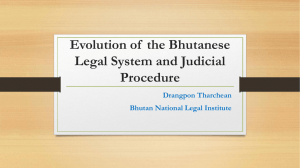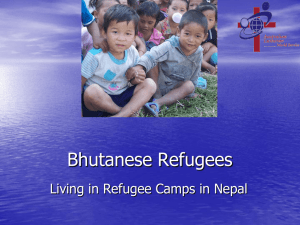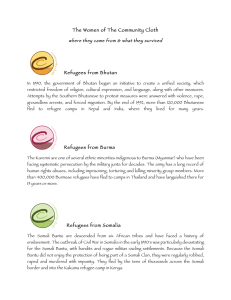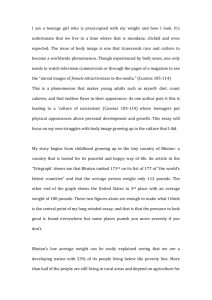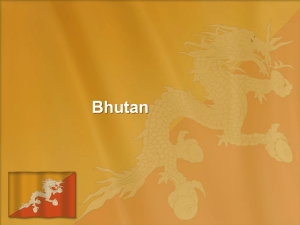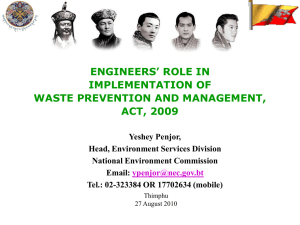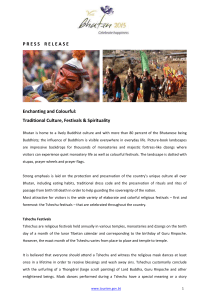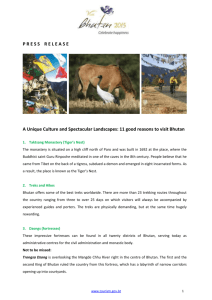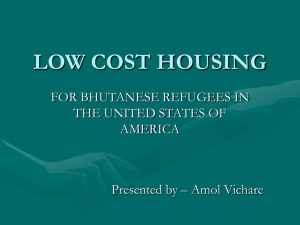Bhutanese Refugees in Omaha
advertisement
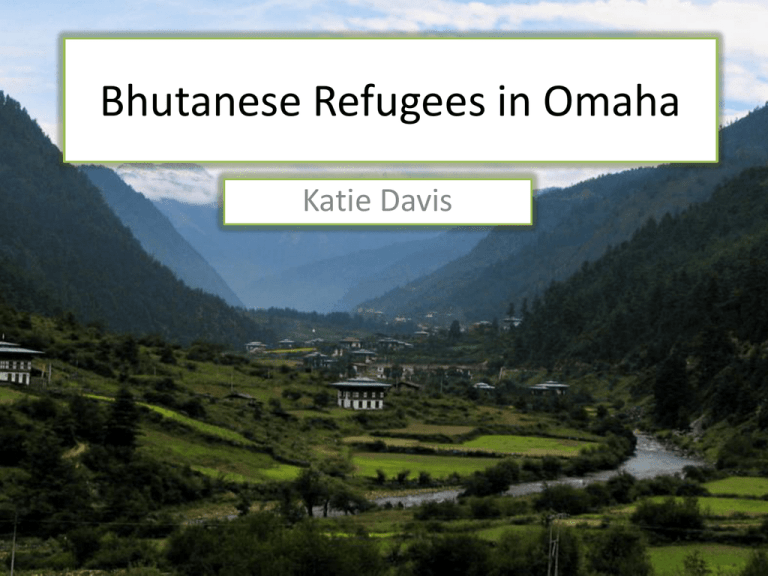
Bhutanese Refugees in Omaha Katie Davis Intro to the Conflict • Bhutan • Ethnic groups: – Lhotshampa – Ngalong • “Bhutanization” – One nation, One People • 100,000 displaced http://www.photovoice.org/bhutan/index.php?id=1 Timeline Late 19th – early 20th century: Organized settlement of south Bhutan for cultivation. Many ethnic Nepalese arrived as agricultural laborers. 1958- Bhutan passed its first citizenship act 1960s-1970s- Southern Bhutan continues to grow in economic prominence 1980s- “One nation, one People” policies promote northern Bhutanese culture 1985- A new citizenship act passed- repressive actions 1991-1992 refugees flow into Nepal 1990s-2006-all bilateral negotiations between Nepal and Bhutan fail. 2006- the U.S., Australia, Canada, Denmark, the Netherlands, New Zealand and Norway offer to resettle refugees. 2008- third country resettlement begins. (57,000 refugees resettled in U.S. 2013) 2012- consolidation of the camps today: In Nepal, more than 69,000 of an original total of 108,000 refugees from Bhutan have been resettled. (http://www.unhcr.org/pages/49e487646.html) Bhutanese in Omaha • • • • • • 2008 2,000 Midtown/Benson Lutheran Family Services Omaha Together One Community (OTOC) Yates Community Center (32nd davenport) KVNOnews.com Teaching Context • • Culturally: – Strong family ties/Patriarchal – Taught to respect authority – Education is very important Traumatic stressors: – Pre-arrival stressors: • Lack of nationality or citizenship • Having to flee their homes suddenly • Lack of freedom of movement – Post-arrival stressors: • Worries about family back home • Language barriers • Lack of choice • Increased family conflict • Poverty/employment issues • Acculteration issues (Cochran et al, 2013) (Benson et al, 2011) Strategies: 1. Family involvement 2. SIOP language supports 3. Help from counselor/social worker (Haynes, 2013) CRT Strategies • Focus on helping learn school rules and proceduresexplicitly explain to them and demonstrate! • Usually will not volunteer in giving answers/sharing feelings/or debate. Give them time to adjust. • Don’t single them out in front of the class. Conference with them one on one. • Often look for direct instruction because that is the way most families communicate with their children. Don’t be passive with instructions. (Chiang, 2000) Culture: Banki, Susan (2008) “Chapter 2 Resettlement of the Bhutanese from Nepal: The Durable Solution Discourse.” Protracted Displacement in Asia: No Place to Call Home. Ashgate Publishing. Benson et al (2011) “Religious coping and acculturation stress among Hindu Bhutanese.” International Social Work. 55(4) 538-553. Carter, Leslie and Bhim Gurung (2011) Now We Will. Omaha Public Schools English as a Second Language Migrant and Refugee Education. Cochran et al (2013) “Suicide and Suicidal Ideation Among Bhutanese Refugees- United States, 20092012.” Morbidity and Mortality Weekly Report. July 5 2013. Vol. 62, No. 26. Quigley, John (2004) “Bhutanese refugees in Nepal: What role nor for the European Union and the United Nations High Commission for Refugees?” Contemporary South Asia. 13(2) 187-200. http://www.photovoice.org/bhutan/index.php?id=1 http://www.unhcr.org/pages/49e487646.html http://www.kvnonews.com/2013/11/hey/ CRT Strategies: “Welcoming Refugee Students: Strategies for Classroom Teachers.” Bureau of Refugee and Immigrant Assistance (BRIA) New York State Office of Temporary and Disability Assistance. http://otda.ny.gov/programs/bria/documents/WtOS-Strategies-for-Teachers-Brochure.pdf Chiang, Linda H.(2000) 'Teaching Asian American students', The Teacher Educator, 36: 1, 58 — 69. http://edt2.educ.msu.edu/DWong/te150s11/CourseReader/ChiangTeachingAsianAmerStudents.pdf Haynes, Judie. (2013) “SIOP: Making Content Comprehensible for ELLs.” http://www.everythingesl.net/inservices/using_siop_model_08621.php.php
